Chapter 22C.150
ELECTRIC VEHICLE INFRASTRUCTURE AND BATTERIES
Sections:
22C.150.020 Vehicles and traffic.
22C.150.030 Off-street parking – Electric vehicle charging stations.
22C.150.040 Accessible electric vehicle charging stations.
22C.150.060 Streets, sidewalks and public places.
22C.150.010 Allowed uses.
Electric vehicle charging stations (Figure 1), rapid charging stations (Figure 2) and battery exchange stations (Figure 3) are permitted in accordance with Chapter 22C.010 MMC, Residential Zones, and Chapter 22C.020 MMC, Commercial, Industrial, Recreation and Public Institutional Zones.
Figure 1: Electric Vehicle Home Charging Station
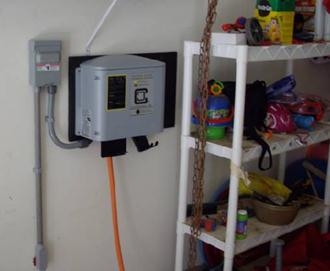
Wall-mounted Level 2 home charging station
Figure 2: Electric Vehicle Rapid Charging Stations
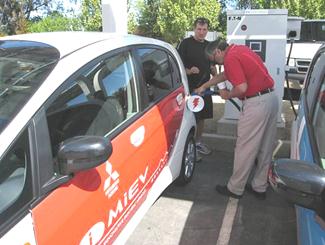

Rapid Charging Stations in Vacaville, CA
Figure 3: Electric Vehicle Battery Exchange Stations

Battery Exchange Station in Tokyo
(Ord. 2852 § 10 (Exh. A), 2011).
22C.150.020 Vehicles and traffic.
(1) Electric Vehicle Charging Stations – Generally.
(a) Electric vehicle charging stations are reserved for parking and charging electric vehicles only.
(b) Electric vehicles may be parked in any space designated for public parking, subject to the restrictions that would apply to any other vehicle that would park in that space.
(2) Prohibitions.
(a) When a sign provides notice that a space is a designated electric vehicle charging station, no person shall park or stand any nonelectric vehicle in a designated electric vehicle charging station space. Any nonelectric vehicle is subject to fine or removal.
(b) Any electric vehicle in any designated electric vehicle charging station space and not electrically charging or parked beyond the days and hours designated on regulatory signs posted at or near the space shall be subject to a fine and/or removal. For purposes of this subsection, “charging” means an electric vehicle is parked at an electric vehicle charging station and is connected to the charging station equipment.
(3) Noticing of Electric Vehicle Charging Stations. Upon adoption by the city of Marysville, the city engineer shall cause appropriate signs and marking to be placed in and around electric vehicle charging station spaces, indicating prominently thereon the parking regulations. The signs shall define time limits and hours of operation, as applicable, shall state that the parking space is reserved for charging electric vehicles and that an electric vehicle may only park in the space for charging purposes. Violators are subject to a fine and/or removal of their vehicle. (Ord. 2852 § 10 (Exh. A), 2011).
22C.150.030 Off-street parking – Electric vehicle charging stations.
To ensure an effective installation of electric vehicle charging stations, the regulations in this section provide a framework for when a private property owner chooses to provide electric vehicle charging stations.
(1) Electric Vehicle Charging Station Spaces.
(a) Purpose. For all parking lots or garages, except those that include restricted electric vehicle charging stations.
(b) Number. No minimum number of charging station spaces is required.
(c) Minimum Parking Requirements. An electric vehicle charging station space may be included in the calculation for minimum required parking spaces that are required pursuant to other provisions of this code.
(d) Location and Design Criteria. The provision of electric vehicle parking will vary based on the design and use of the primary parking lot. The following required and additional locational and design criteria are provided in recognition of the various parking lot layout options.
(i) Where provided, parking for electric vehicle charging purposes is required to include the following:
(A) Signage. Each charging station space shall be posted with signage indicating the space is only for electric vehicle charging purposes. Days and hours of operations shall be included if time limits or tow-away provisions are to be enforced.
(B) Maintenance. Charging station equipment shall be maintained in all respects, including the functioning of the charging equipment. A phone number or other contact information shall be provided on the charging station equipment for reporting when the equipment is not functioning or other problems are encountered.
(C) Accessibility. Where charging station equipment is provided within an adjacent pedestrian circulation area, such as a sidewalk or accessible route to the building entrance, the charging equipment shall be located so as not to interfere with accessibility requirements of WAC 51-50-005.
(D) Lighting. Where charging station equipment is installed, adequate site lighting shall exist, unless charging is for daytime purposes only.
(E) Notification. Information on the charging station, identifying voltage and amperage levels and any time of use, fees, or safety information.
(e) Data Collection. To allow for maintenance and notification, the Marysville community development department will require the owners of any private new electric vehicle infrastructure station that will be publicly available (see definition “electric vehicle charging station – public” in MMC 22A.020.060) to provide information on the station’s geographic location, date of installation, equipment type and model, and owner contact information. (Ord. 2852 § 10 (Exh. A), 2011).
22C.150.040 Accessible electric vehicle charging stations.
(1) Quantity and Location. Where electric vehicle charging stations are provided in parking lots or parking garages, accessible electric vehicle charging stations shall be provided as follows:
(a) Accessible electric vehicle charging stations shall be provided in the ratios shown on the following table.
|
Number of EV Charging Stations |
Minimum Accessible EV Charging Stations |
|---|---|
|
1 – 50 |
1 |
|
51 – 100 |
2 |
|
101 – 150 |
3 |
|
151 – 200 |
4 |
|
201 – 250 |
5 |
|
251 – 300 |
6 |
(b) Accessible electric vehicle charging stations should be located in close proximity to the building or facility entrance and shall be connected to a barrier-free accessible route of travel. It is not necessary to designate the accessible electric vehicle charging station exclusively for the use of disabled persons. Below are two options for providing for accessible electric vehicle charging stations.
Figure 4: Off-Street Accessible Electric Vehicle Charging Station – Option 1
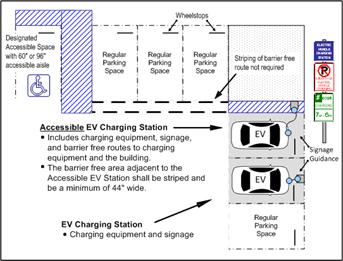
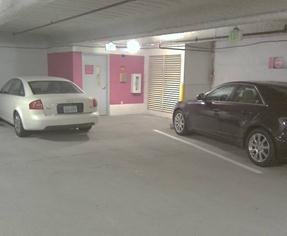
Figure 5: Off-Street Accessible Electric Vehicle Charging Station – Option 2
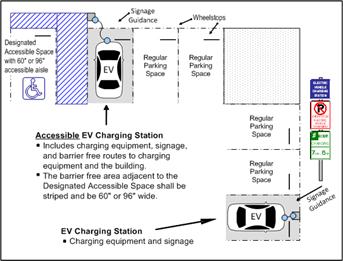
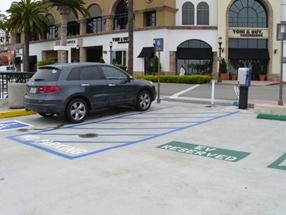
(2) Definitions.
(a) “Designated accessible space” means a WAC 51-50-005 required accessible parking space designated for the exclusive use of parking vehicles with a state disabled parking permit.
(b) “Accessible electric vehicle charging station” means an electric vehicle charging station where the battery charging station equipment is located within accessible reach of a barrier-free access aisle (minimum 44-inch width) and the electric vehicle. (Ord. 2852 § 10 (Exh. A), 2011).
22C.150.050 Signage.
(1) Directional – Off-Street Parking Lot or Parking Garage. Directional signs for an on-site parking lot or parking garage should be used in the parking facility with a directional arrow at all decision points, as depicted in Figure 6.
Figure 6: Directional – Off-Street Parking Lot or Parking Garage
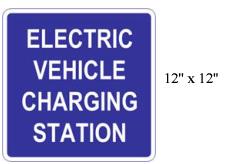

(2) Off-Street EV Parking – Parking Space with Charging Station Equipment. Combination signs identifying space as an electric vehicle charging station, prohibiting nonelectric vehicles, with charging time limits, should be provided, as depicted in Figure 7.
Figure 7: Off-Street EV Parking – Parking Space with Charging Station Equipment
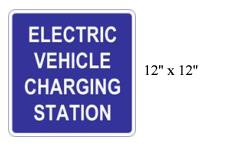
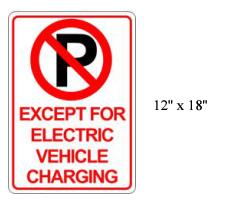
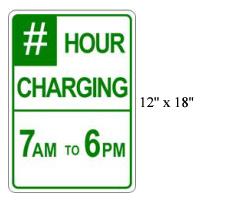
(Ord. 2852 § 10 (Exh. A), 2011).
22C.150.060 Streets, sidewalks and public places.
(1) On-Street Electric Vehicle Charging Stations – Generally.
(a) Purpose. Curbside electric vehicle charging stations adjacent to on-street parking spaces are reserved for charging electric vehicles.
(b) Size. A standard size parking space may be used as an electric vehicle charging station.
(c) Location and Design Criteria. Where provided, parking for electric vehicle charging purposes is required to include the following:
(i) Signage. Each charging station space shall be posted with signage indicating the space is only for electric vehicle charging purposes. Days and hours of operations shall be included if time limits or tow-away provisions are to be enforced.
(ii) Maintenance. Charging station equipment shall be maintained in all respects, including the functioning of the charging equipment. A phone number or other contact information shall be provided on the charging station equipment for reporting when the equipment is not functioning or other problems are encountered.
(iii) Accessibility. Charging station equipment located within a sidewalk shall not interfere with accessibility requirements of WAC 51-50-005.
(iv) Clearance. Charging station equipment mounted on pedestals, light posts, bollards or other devices shall be a minimum of 24 inches clear from the face of curb.
(v) Lighting. Where charging station equipment is installed, adequate site lighting shall exist, unless charging is for daytime purposes only.
(vi) Charging Station Equipment. Charging station outlets and connector devices shall be no less than 36 inches or no higher than 48 inches from the top of surface where mounted, and shall contain a retraction device and/or a place to hang permanent cords and connectors sufficiently above the ground or paved surface.
(vii) Charging Station Equipment Protection. When the electric vehicle charging station space is perpendicular or at an angle to curb face and charging equipment, adequate equipment protection, such as wheel stops or concrete-filled steel bollards, shall be used. Appropriate signage indicating if backing in is allowed or not shall be posted.
(viii) Notification. Information on the charging station identifying voltage and amperage levels and any time of use, fees, or safety information.
(ix) Location. Placement of a single electric vehicle charging station is preferred at the beginning or end stall on a block face.
(d) Data Collection. To allow for maintenance and notification, the community development department will require the owners of any private new electric vehicle infrastructure station that will be publicly available (see definition “electric vehicle charging station – public” in MMC 22A.020.060) to provide information on the station’s geographic location, date of installation, equipment type and model, and owner contact information.
Figure 8: Electric Vehicle Charging Station – On Street
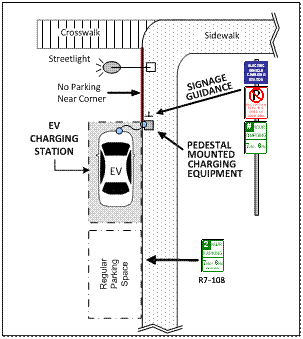
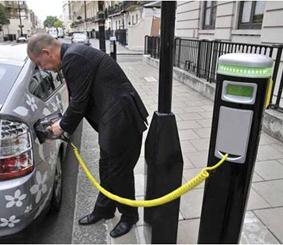
On-street charging near end of block.
(2) Signage.
(a) Directional – Highways and Freeways. Directional signs (MUTCD D0-11b) for highways and freeways (Figure 9) should be installed at a suitable distance in advance of the turn-off point or intersection highway. If used at an intersection or turn-off point, it shall be accompanied by a directional arrow. As the symbol on Figure 9 appears to be a gasoline pump, this sign may also be supplemented with the sign shown in Figure 10 (MUTCD D9-11bP) to avoid confusion with liquid fuel stations for early EV drivers.
Figure 9: Directional – Highways and Freeways
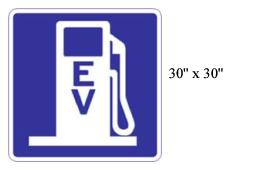

Figure 10: Supplemental Directional – Highways and Freeways
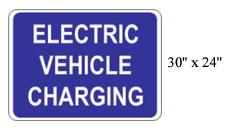
(b) Directional – Local Street. The directional sign for local streets should be installed at a suitable distance in advance of the intersection or charging station facility. If used at an intersection or parking lot entrance, it shall be accompanied by a direction arrow. As the symbol on Figure 11 appears to be a gasoline pump, this sign may also be supplemented with the sign shown in Figure 12 (MUTCD D9-11bP) to avoid confusion with liquid fuel stations for early EV drivers.
Figure 11: Directional – Local Street
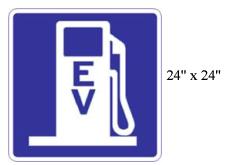

Figure 12: Supplemental Directional – Local Street
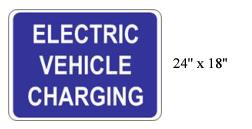
(c) On-Street Parking Space with Charging Station Equipment. Combination sign identifying space as an electric vehicle charging station, prohibiting nonelectric vehicles, with charging time limits, is shown in Figure 13. The use of time limits is optional and is included to allow the charging equipment to be available for more than one use during the day. The design of the time limit charging sign is modeled after the existing R7-108 sign in the federal MUTCD. If dual use of the space is allowed, the time limits would need to be added to the red/black/white sign rather than the green sign.
Figure 13: On-Street Parking Space with Charging Station Equipment
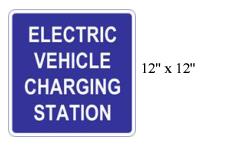
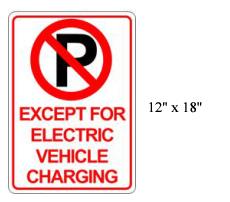
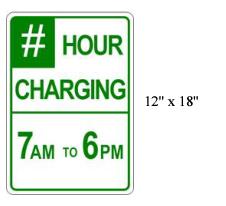
(Ord. 2852 § 10 (Exh. A), 2011).
22C.150.070 SEPA.
(1) Categorical Exemptions for Battery Charging and Exchange Station Installation. The construction of an individual battery charging station or an individual battery exchange station that is otherwise categorically exempt shall continue to be categorically exempt even if part of a larger proposal that includes other battery charging stations, other battery exchange stations, or other related utility networks. (Ord. 2852 § 10 (Exh. A), 2011).


